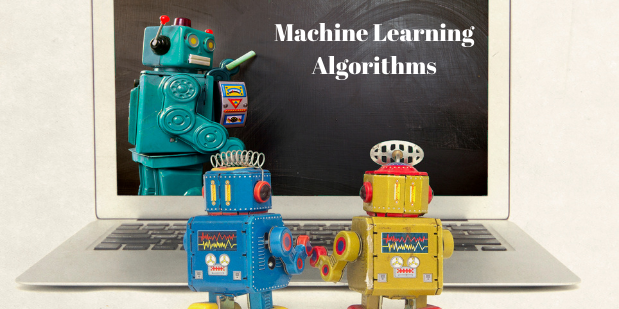Four prime types of Machine Learning Algorithms

How do you distinguish a machine from a man? Humanoids may have indistinguishable physical features and yet they are ‘humanoids’ not ‘humans’. Of course, we humans learn from experience, we evolve and machines have to be instructed and provided inputs for developing into a better version.
But what if the machines/computer learn and evolve from experience as well? That is Artificial Intelligence and here is where we are introduced to Machine Learning. The ‘experiences’ are replaced by ‘data’, so our data becomes the material, the processing of our data is Machine Learning and the result is Artificial Intelligence.
But what exactly does Machine Learning do? Machine Learning brings together gathered statistics/data (labelled and non-labelled) and computer science to help computers learn how to do a given task, without being programmed to do so. Just as our brain uses our past experiences and errors to improve a task, so does a machine or computer. The machine uses our data, likes or dislikes and its errors to evolve in mastering a task.
Without even realising it, we come across AI(Artificial Intelligence) that are constantly evolving and bettering in our day-to-day life. Thanks to Machine Learning.
Types of Machine Learning Algorithms
1) Supervised Machine Learning
2) Unsupervised Machine Learning
3) Semi-Supervised Machine Learning
4) Reinforcement Machine Learning
Now let’s take a better look at these four primary growing branches from the gigantic trunk of Machine Learning
Supervised Machine Learning is the type of Machine Learning where all materials are ‘labelled’ to help the machine predict the precise and correct value. Here, ‘labelled’ means to load the machine with knowledge so that we can have it predict future instances, this type is the easiest for the machine.
Now to make it easier to understand, let us take the example of certain platforms say-Spotify or YouTube.
On Spotify, you click on the ‘like’ icon or add to your playlist the kind of songs you would like to listen to again. This might depend on the genre and intensity of the songs. The next time you open Spotify, it already has recommendations based on your previous choices of songs and you already are clicking on one of the displayed playlists. Isn’t that familiar and easy?
Similarly, on YouTube, when you like and watch videos based on different genres and topics, the recommended videos are customised to suit your taste.
No, this is no magic or coincidence, this where Supervised Machine Learning comes into play. The choices you have made by liking or disliking materials have enabled apps like Spotify and YouTube to precisely predict your taste in YouTube videos and songs. This data that you have provided is ‘labelled’- the kind of videos you have watched on YouTube, the types of songs you have listened on Spotify, all of this has been used to modify recommendations for you, the computer now knows what is your likes and dislikes, what kind of material you would surely approve of and thus offers you materials accordingly.
This is the result of Supervised Machine Learning. The data has been provided to the machine for its better performance.
The primary purpose of Supervised Machine Learning is to scale or approximate the scope of data and make predictions of future, unavailable or unseen on the basis of the labelled sample data.
Supervised Machine Learning uses two major processes:
Classification:- This process employs the past data samples and manually trains the machine to predict outcomes accordingly.
Regression:- It is the process of identifying patterns and calculating the predictions of continuous outcomes.
Most widely used Supervised Machine Learning Algorithms are:
Linear Regression
Logistic regression
Random Forest
Gradient Boosted Trees
Supervised Machine Learning can be used in predicting customer choices of brands and products and demands in the marketing sector, facilitating navigation and even in biodata storage and recognition.
Now, what if there is no input of data? How would a computer evolve and better itself in a particular task?
Here comes Unsupervised Machine Learning. Manual classification is not involved in this method.
For instance, a child can guess that if 1+2= 3 then 1+3=4, simple.
But what would the child do if he/she is given the problem 3 x 2 without any previous example by the teacher? Most probably, the child gets the answer wrong on his/her first attempt but on trying several attempts the child catches the pattern that 3 x 2= 3+3 thus the answer is 6. The next time the child is given 5 x 4 he/she calculates that 5+5+5+5=20 so 5 x 4=20 and as the child learns and grows up he/she can take on larger numbers like 12 x 5 = 60.
That is exactly what the computer does in case of Unsupervised Machine Learning, it learns and evolves by classifying materials itself and detecting the characteristics of the data to predict the precise or required outcome. The difference is that the machine would not take as long as the human mind to learn from its errors and by classifying the self-acquired data.
How do you think the computer is now able to detect suspicious activities like transaction fraud and possible hacking?
Unsupervised Machine Learning can result in more errors, however.
In Unsupervised learning is, as it sounds, we do not provide information to the computer but let it discovers the data on its own which may not be visible to the human eye. Unsupervised learning uses machine learning algorithms that draw conclusions on unlabelled data.
Unsupervised Machine Learning employs two chief methods to describe the data:
Clustering:- It is the analysis of patterns and grouping of unlabelled data
Dimensionality Reduction:- The machine distils the relevant data while reducing the less relevant data.
Commonly used Unsupervised Algorithms are:
K-means Clustering
Principal Component Analysis
Association Rule
Unsupervised Machine Learning can be used in Digital Marketing(yes again) in determining the target customer or audience and adjustment of relevant services as required like protection of private data, safe net-banking.
Now that we know of Supervised and Unsupervised Machine Learning, what is Semi-Supervised Machine Learning?
Semi-Supervised Machine Learning, as the name suggests is the hybrid of Supervised Machine Learning and Unsupervised Machine Learning. A small amount o data is labelled and the computer is required to find features through labelled data and then classify other data accordingly. The use of limited sets of labelled data results in a partially trained model that later gets to analyse the unlabelled data. This is the most commonly used method as it guarantees better, more precise predictions and outcomes. Getting labelled data can be hard in many ways but it helps in providing accuracy, on the hand, unlabelled data is inexpensive but the computer is prone to more errors while dealing with unlabelled data. So Semi-Supervised Machine Learning is a middle ground between these two, unifying the pros of these two types of Machine Learning in order to cancel out the cons.
Take a school mock-test for example, the teacher usually prepares the mock question papers. The questions in the mock-test give the students some insight into the questions which would or are most likely to be asked in the actual or final test. The students prepare accordingly as they now have some idea of the pattern and type of questions to be expected in the final test.
Now consider the labelled data as the mock-test questions, the computer as a student and the unlabelled data as the questions those appear in the final exam, with the combined knowledge the computer is able to produce extremely satisfactory outcomes in most of the cases.
Semi-Supervised Machine Learning uses the Classification Process to identify data assets as well as the Clustering Process in order to group the data into distinct parts
Semi-Supervised Algorithm is used primarily in Healthcare and Legal industries and in web content classification.
Now, what if the machine is trained through its observations and previous errors in order to produce the best possible outcomes?
Here is where we are introduced to Reinforcement Machine Learning. What distinguishes this method from the rest above is the primary use of exploitation and exploration. The action is carried out, the consequences are observed along with the environment and its patterns and the next action is mainly based on the consequences of the previous action. In this type of Machine Learning, the computer gathers information from its interaction with the environment and the actions are taken accordingly in order to maximize the profit and minimize the risks.
Take the concept of adaptability for example, according to the famous naturalist Charles Darwin, only the fittest survives, and who is the fittest? The one that continues to adapt and evolve for this, the being observes its surroundings, learns from its previous errors and keep exploring.
The computer does something similar while using the Reinforcement Machine Learning to train itself in order to fit into the environment and provide satisfactory results. In Reinforcement Machine Learning, there is no labelled material but the computer learns which step is correct and which step is wrong or risky through the given feedbacks.
Let’s take the example of a newly-opened restaurant, the chef would use the feedback given by the customers and food critics in order to better the dishes. Right?
That is what Reinforcement Machine Learning does. It takes up feedback and betters itself at the given task and adapts to the environment. Much like a human mind that learns from experience, the machine learns from ‘errors’.
Most commonly used Reinforcement Algorithms include:
Temporal Difference
Q-Learning
Monte-Carlo Tree Search
Reinforcement Machine Learning can be used when limited or inconsistent data is available, Video Games also uses this method for bettering the games’ overall experience, self-driving cars also rely on Reinforcement Learning algorithms.
Is it not amazing how Machine Learning has evolved from just a subject of mega-science- fiction or fancy to real-world subjects of study and means of development? We are more familiar with Machine Learning than we even realise after all. Take Google Maps for example, how does it predict which is the fastest route to our destination? How is it that the product you were viewing on an online shopping site just a few hours ago is advertised on various websites and online platforms you visit?
That’s the power of Machine Learning.
Read More: VerveLogic
# How Much Does It Cost to Make an App
# How to Hire iOS App Developer
# Tinder Alternatives: Best Dating Apps Like Tinder 2020
# How to Outsource Mobile App Development
# Big Data and Machine Learning
# Functional vs Non-Functional Requirements: Main Differences & Examples
# 9 Best Stock Marketing Apps of 2020
# 10 Best Calendar Apps for Android and iOS
# 25 Best Programming Languages for Mobile Apps





Some genuinely nice and useful information on this site, as well I believe the style holds wonderful features.